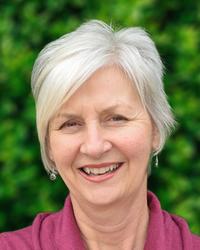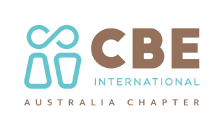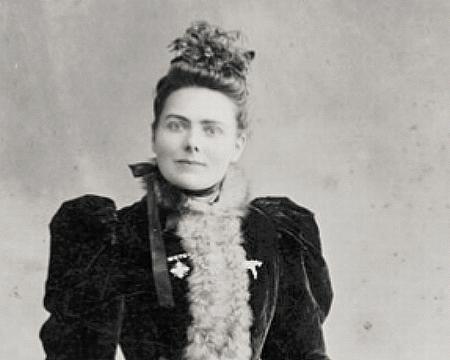Meet Bessie Harrison-Lee
By Dr Barbara Deutchmann
Meet Bessie Harrison-Lee
Let me introduce you to Bessie Harrison-Lee and her world. It’s a bit of a stretch, thinking we can imagine her world from this distance in time and it is always a temptation to make it fit our labels and our views. Still, there are things for us to learn even if there are things about Bessie (and I hope she would not mind that I call her by that name) that make us scratch our heads and ponder her choices. How do we assess Christian women from over a century’s distance? The first thing to ponder is why more of us don’t know about her. She lived an astounding life, was a fêted international speaker with dramatic flair, a prolific writer of Christian materials, and an active campaigner for social improvement. Along with Louisa Lawson and William Lane she was recognised as a strategic reformer in the late nineteenth century.
She was born in 1860 into a different world in Daylesford, a small central Victorian hamlet. Her father was a butcher/miner and, because her mother died when Bessie was eight years old, she was sent to live with relatives close to Eildon. Her childhood was an unhappy one in a home affected by alcohol, poverty and violence. After her religious conversion, she married and adopted a temperance lifestyle. She and her railway-worker husband lived in the Footscray and Richmond areas of Melbourne and, concerned about the gross social effects of alcohol, Bessie worked with a doctor visiting the sick and those in gaol. Her first husband died and in 1908 she married a New Zealand farmer and subsequently lived in New Zealand, Hawaii and California.
It helps to know a little about her times. The late nineteenth century was a time of social flux in the Australian colonies and some big debates exercised colonial minds. One debate was “the woman question†and concerned the place of women, their access to family resources, and their control over the things that determined their lives. Increasingly gaining paid employment and acquiring higher education, women were reacting against the nineteenth century ideal of women that celebrated purity, piety, and submissiveness. Aligned against it was a strong masculinist culture attempting to define Australian manhood and reacting against the movement of women out of domestic spaces. The Australian frontier conditions encouraged a masculine culture displaying casual sex, drinking, and gambling. Writers of The Bulletin magazine ridiculed feminists and vilified Bessie Harrison-Lee, taking exception to her views on marriage, thundering, “Marriage plays too important a part in the life of the modern civilised man. He is cramped and coffined in on every hand.â€
When we assess the role of Christian women in early centuries, we applaud them for prising open public spaces for women’s voices and perspectives. Bessie deserves a lot of credit for this. She was an active campaigner for female suffrage and organised many of the signatures that made up the Monster Petition to parliament in 1891. By her example and prodigious work ethic, she pushed the boundary on women’s public speaking, gaining a reputation even with mixed audiences, known then as “promiscuous audiencesâ€. At this point we might finish the article, close the book on Bessie Harrison-Lee, thanking God for her life and work. That would be a disservice. Bessie was a woman not only interested in creating voice and visibility for women, valuable and all as that would have been. What is important about her and many of her colleagues, is that she was driven by an expansive Christian social vision that encompassed the radical idea of male and female as co-workers in shaping a new society.
Bessie was not theologically-educated but had read the writings of Katharine Bushnell, a contemporary American writer whose book God’s Word to Women interpreted Genesis and New Testament epistles in refreshing ways. Bushnell, for instance, argued that God formed the woman in Genesis 2 in response to the man’s waywardness. In place of “alone,†in Gen 2:18 (The LORD God said, “It is not good that man should be alone†NRSV) she offered “in his separationâ€. Eve was formed, she argued, “to help Adam recover himselfâ€. This novel reading of Genesis 2 strengthened an argument about women’s place in society that resonated with the women who were finding their feet in the public squares of Australia. Bessie argued that women be given the role of moral guardians of society.
She was an advocate for companionate marriage, writing and speaking openly about marital sexuality, strongly contending against male sexual conventions. She attacked the supposed right of husbands to their wives’ bodies. In a letter to the Melbourne Herald in October 1888 she wrote: “ . . . marriage, as it is, has been degraded to the most unholy gratification of men’s worst desires and the result is – little children coming unwished for and un-provided for . . ..â€
She found common cause with the Women’s Christian Temperance Union (WCTU), a powerful body set up in the USA in 1873, fighting for control of alcohol, women’s suffrage and labour rights. Bessie’s extensive travel and public speaking around Australia was instrumental in setting up over 40 branches. She was appointed a world missionary for the WCTU in 1911, one of only a few women to achieve this. She and her colleagues were the inheritors of a tradition that had brought evangelical women out of domestic settings in England into public squares to join the anti-slavery movement. Despite this inherited liberal tradition, her work shows a sad lack of awareness of the lives of Aboriginal women and her views of Asian people shared the racist proclivities of the times.
Within this powerhouse of women, many, like Bessie, were evangelical Christians and espoused millenarian beliefs, holding that they were preparing the ground for Christ’s coming. Members of the WCTU saw no tension between advocating for women’s rights and working to save souls. The sharp line between sacred and secular causes that frames much Christian endeavour today did not exist for Bessie and her colleagues.
Learning about Bessie’s work revives understanding of women’s evangelicalism in Australia and the critical role it played not only in advancing women’s causes but in shaping the nation in Federation-era Australia. Bessie’s work encompassed all types of Christian mission: incarnational presence, charitable works, public activism, political advocacy, preaching, and influential writing. We rarely celebrate our female nation-builders and even more rarely celebrate the Christian foundations of their work. Rest assured, Bessie Harrison-Lee, were she here today, would be an enthusiastic, if provocative member of Christians for Biblical Equality!
(With thanks for Jenny Caligari, Deakin University, who gave me access to her PhD thesis on Bessie Harrison-Lee)

Barbara Deutschmann
Since retiring from TEAR Australia in 2017, Barbara has been working on understanding how the Bible (especially the Old Testament/ Hebrew Bible) speaks relevantly to current life issues. Last year she completed a PhD on gender in the Eden narrative and is now a post-doctoral research associate with the University of Divinity in Melbourne. She serves on the Board of Tearfund Australia and the Evangelical Alliance of Australia.
Barbara has been a secondary teacher and health program trainer in India, seconded through Interserve Australia.
She shares life with partner, Peter, three adult children and three grandchildren and is an active member of St Mark’s Anglican Church, Spotswood in the parish of Yarraville





